Create
Final Report - Acare
Final Report - Acare
- No tags were found...
Create successful ePaper yourself
Turn your PDF publications into a flip-book with our unique Google optimized e-Paper software.
THE IDEAS<br />
IV.<br />
Fig.32.<br />
Artist’s impression<br />
of wing mounted<br />
generators to retrieve<br />
energy from the vortex<br />
produced when flying<br />
to keep torsion loads on the wing box<br />
reasonable, (c) Is not too big for airport<br />
handling and for cruise tip speed (noise),<br />
(d) Has a turning device (ERD) to gather<br />
the energy and (e) Is retractable for<br />
ground handling.<br />
10.3. Space based solar power<br />
Most modern industrial transport, agricultural<br />
and industrial systems depend on the<br />
availability of fossil fuel at relative low cost.<br />
The point in time when the maximum rate<br />
of global petroleum extraction is reached is<br />
known as peak oil. Predictions vary greatly<br />
as to the year when this peak oil will occur.<br />
However, product life cycles in the aviation<br />
industry typically range from 40 to 60 years.<br />
Given these long life cycles it is necessary to<br />
think today about alternative fuels for aviation,<br />
even if the exact year of peak oil is not known.<br />
One possible solution is the development of<br />
substitutes for petroleum, e.g. bio-fuels. A<br />
second aspect is the environmental impact.<br />
The development of electric propulsive systems<br />
for aircraft seems to be a promising long term<br />
approach. Thereby, the aircraft runs on electrical<br />
power rather than internal combustion engines,<br />
with electricity coming from fuel cells, solar<br />
cells, ultra-capacitors, power beaming and/or<br />
batteries. A major factor when designing an<br />
aircraft is weight. Fuel cells, ultra-capacitors or<br />
batteries do not seem to create weight savings.<br />
The effectiveness of aircraft-mounted solar cells,<br />
on the other hand, would be limited by cloud<br />
coverage, the available fuselage and wing area<br />
and solar power availability. Power beaming<br />
is another possibility of providing an aircraft<br />
with the necessary electrical power. With this<br />
concept, only a small amount of energy needs<br />
to be stored onboard for take-off and landing.<br />
During cruise, energy is provided by a power<br />
beaming mechanism. An almost unlimited<br />
source for this power beam is given by the sun.<br />
Space based solar power is a concept that has<br />
been explored since the 1970s.<br />
Space-based solar power consists of three parts:<br />
a means of collecting solar power in space,<br />
for example via solar cells or a heat engine,<br />
a means of transmitting power to earth, for<br />
example via microwave or laser and a means of<br />
receiving power. The proposed concept of solar<br />
energy conversion in space and wireless power<br />
transfer to aircraft can be segmented as follows.<br />
First, sunlight needs to be converted to electric<br />
energy. Recent research describes either thinfilm<br />
solar cells or solar dynamic power systems<br />
as two possible approaches.<br />
The next step concerns the transmission of<br />
this electric energy. The two main mechanisms<br />
79



